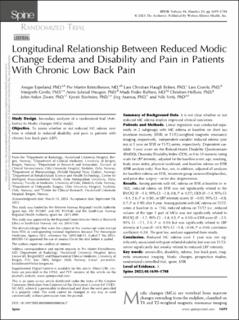| dc.description.abstract | Study Design.
Secondary analyses of a randomized trial [Antibiotics In Modic changes (MCs) study].
Objective.
To assess whether or not reduced MC edema over time is related to reduced disability and pain in patients with chronic low back pain (LBP).
Summary of Background Data.
It is not clear whether or not reduced MC edema implies improved clinical outcomes.
Patients and Methods.
Linear regression was conducted separately in 2 subgroups with MC edema at baseline on short tau inversion recovery (STIR) or T1/T2-weighted magnetic resonance imaging, respectively. Independent variable: reduced edema (yes/no) at 1 year on STIR or T1/T2-series, respectively. Dependent variable: 1-year score on the Roland-Morris Disability Questionnaire (RMDQ), Oswestry Disability Index (ODI), or 0 to 10 numeric rating scale for LBP intensity, adjusted for the baseline score, age, smoking, body mass index, physical workload, and baseline edema on STIR (STIR analysis only). Post hoc, we, in addition, adjusted all analyses for baseline edema on STIR, treatment group (amoxicillin/placebo), and prior disc surgery—or for disc degeneration.
Results.
Among patients with MC edema on STIR at baseline (n = 162), reduced edema on STIR was not significantly related to the RMDQ (B: −1.0, 95% CI: −2.8, 0.8; P = 0.27), ODI (B:−1.4, 95% CI: −5.4, 2.6; P = 0.50), or LBP intensity scores (B: −0.05, 95% CI: −0.8, 0.7; P = 0.90) after 1 year. Among patients with MC edema on T1/T2-series at baseline (n = 116), reduced edema on T1/T2 (i.e., reduced volume of the type 1 part of MCs) was not significantly related to RMDQ (B: −1.7, 95% CI: −3.8, 0.3; P = 0.10) or ODI score (B: −2.3, 95% CI: −7.1, 2.5; P = 0.34) but was significantly related to LBP intensity at 1 year (B: −0.9, 95% CI: −1.8, −0.04; P = 0.04; correlation coefficient: 0.24). The post hoc analyses supported these results.
Conclusion.
Reduced MC edema over 1 year was not significantly associated with pain-related disability but was (on T1/T2-series) significantly but weakly related to reduced LBP intensity.
Level of Evidence.
Level 3. | en_US |

